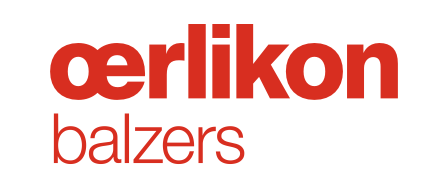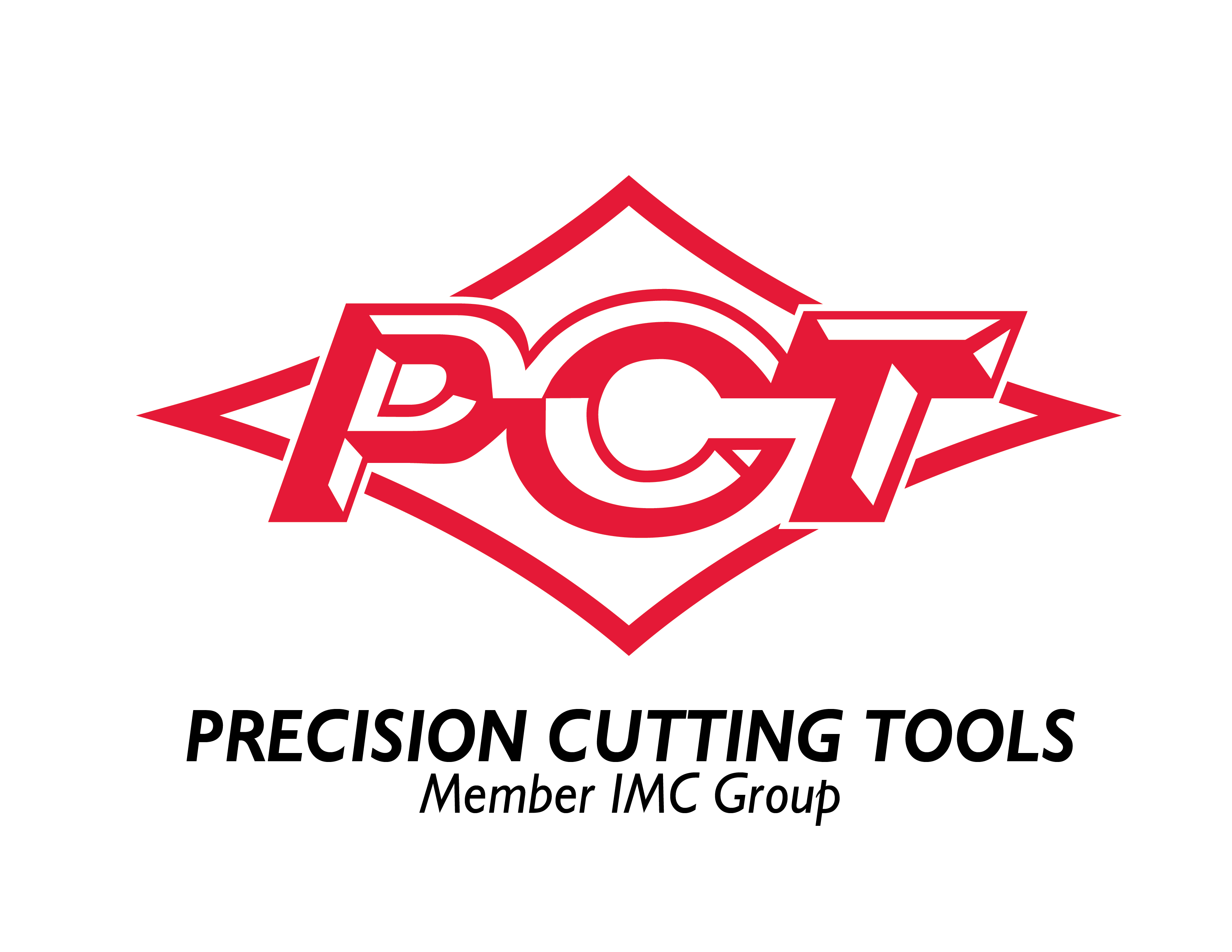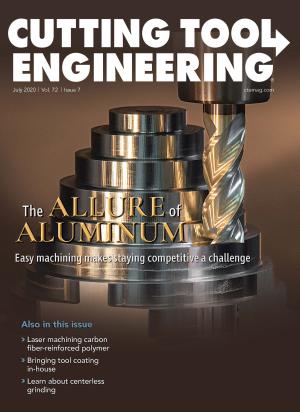Coated cutting tools, such as drills, mills, inserts, threads, reamers, broaches and hobs, tolerate significantly higher cutting speeds and feeds, reducing machining time and costs. Outstanding wear resistance also substantially extends tool life and lowers the cost per piece.
“Anytime that you can make the tool last longer, it’s a great benefit,” said Nikhil Sheth, CEO of Santa Fe Springs, California-based Precision Cutting Tools LLC, a manufacturer of cobalt and carbide tools. “Carbide isn’t cheap, so for maybe 10% of the cost of the tool, you’re adding upward of 50% to the life to the tool.”
He observes that the use of coatings in general has increased as coating technologies simultaneously have continued to improve.
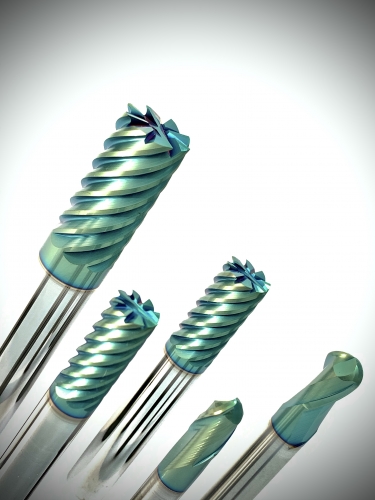
Tool manufacturers can specify special coating colors to distinguish products. Image courtesy of PD2i
“All the new alloys like Inconel and titanium are superlight, but they’re getting harder and harder to cut,” Sheth said. “So the whole coating industry is getting much more niche, more high-tech while at the same time it’s becoming more accessible for manufacturers to get that technology in-house.”
In the past, cutting tool manufacturers often shipped their tools to shops specializing in coatings. But with improvements, such as automation, and increased use of specialized coatings, more toolmakers are finding that bringing coating capabilities in-house makes sense.
Lower Barrier to Entry
For many tool manufacturers, coating is not their main business but an important part of it. Sheth said entering the coating game is much cheaper these days.
“As a previous job coater, most of the large manufacturers that were sending me business have gone ahead and made the investment themselves,” he said. “I think they realize that if they already spend a certain amount of dollars a month on coatings, they’d probably spend the same amount with half the headaches just keeping it in-house.”
Sheth said sending out tools for coating can complicate the manufacturing process.
“Logistically, it can become a nightmare because you have a long turnaround time and you still might lose a package that has $2,000 or $3,000 worth of tools in it,” he said. “Then you have to package it extra carefully to prevent breakage. And when you get the tools back, you still have to inspect them to make sure they’re OK.”
Different Coatings for Different Applications
Christopher Halter, manager of equipment sales and service at Oerlikon Balzers Coating USA Inc., Schaumburg, Illinois, said typical coatings include TiN, TiC, TiCN, MT-TiCN, TiCNO and α/K-Al2O3. Additional components and component groups extend further flexibility to coating designs, such as TiAlN, TiBN, TiB2, CrCx and Cr2O3.
Each coating shop, whether in-house or a provider, develops its own coating recipes. When considering bringing coating in-house, manufacturers may want to focus on four or five recipes that will work best for customers. Specific properties can be adjusted for the different applications in which a tool will be used.
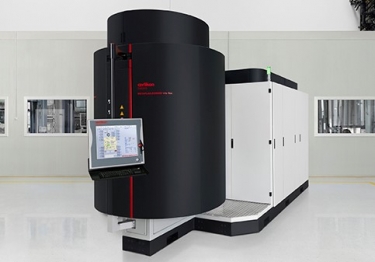
Coating equipment companies offer modular solutions to accommodate different types of coatings for a manufacturer’s specific tool lines. Image courtesy of Oerlikon Balzers Coating USA
“As an example, for drilling, you need a low thermal conductivity, you need hot hardness, you need oxidation resistance, you need chip evacuation, and you need to reduce torque,” said René Scheibe, COO of Paris-based coating equipment maker Partner Development Industry International, which does business as PD2i and has a U.S. location in Fox River Grove, Illinois. “A carbide tool itself cannot supply all these functions. But through a dedicated coating, you can apply these characteristics to your tool.”
Coatings also may add an attractive, shiny appearance and offer options for differentiation and identification.
“Some customers ask us for a standard coating like aluminum chromium nitride, but they want a dedicated color, such as purple or green, for marketing purposes,” said Dirk Haack, CEO of PD2i Europe GmbH, Düren, Germany. “It should look different than the coatings of other companies even if the performance is the same.”
Chemical and Physical Vapor Deposition
While an array of coating technologies has been developed, two of the most common types in the cutting tool industry are chemical vapor deposition and physical vapor deposition.
For the CVD process, reactant gases are piped into a reactor, or furnace, at a specific temperature and pressure. Inside the reactor, the gases come into contact with a heated tool substrate and plate out as a solid layer coating the surface.
PVD coatings are created using one of two techniques. Both start with a high-purity, solid-metal target, such as titanium, chromium or aluminum, which then is evaporated by either heat (arc evaporation) or bombardment with ions (sputtering). At the same time, a reactive gas — for instance, nitrogen or a gas containing carbon — is added to the coating chamber. Ions in the gas form compounds with the metal ions vaporized from the target. These compounds then are deposited on tools or components as a thin, highly adherent coating.
“PVD is a line-of-sight process, so the surface you want to coat needs to be in line with the evaporator to create a uniform coating,” Halter said. “So if we’re talking about shank-type cutting tools, you need to rotate them in the chamber to get a consistent coating thickness distribution.”
Scheibe believes that 80% to 85% of coatings applied to cutting tools today are PVD coatings.
“With PVD, you can play with the hardness, the coefficient of friction, the temperature and the material composition,” he said. “You have all these different materials, which completely change the performance of the coating for many different applications.”
Benefits of In-House Coating
Coating tools in-house provides clear advantages, starting with the difference in costs compared with coating at an outside shop. Coating consumes relatively small amounts of electricity, gas and metal from the target.
“Let’s say it costs $2 to have an endmill coated at a coating shop,” Haack said. “But if you have your own machine, coating the same tool would cost about 20 cents, not including the capex and labor costs.”
Other benefits of bringing coating services in-house are flexibility and simplicity.
“Job coating services need to gather enough tools to fill up a batch, and they tend to run a special coating cycle maybe once a week,” Haack said. “But if you’re doing it in-house, you can control the timing yourself, so the degree of flexibility is much higher.”
“For critical industries with specific quality control needs, having the equipment in-house also can make the quality process simpler — i.e., fewer external supplier audits,” Halter said.
Limitations of In-House Coating
In addition to the initial investment in equipment, there are other considerations when bringing coating capabilities in-house. For example, a company might need to hire and train at least one operator, as well as a supervisor to oversee coating operations.
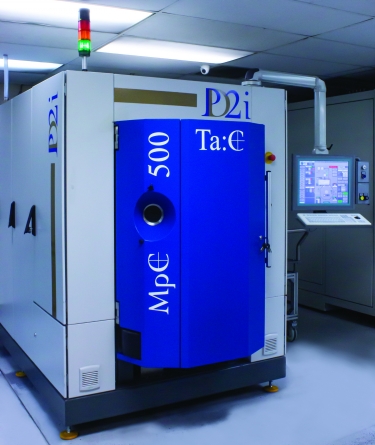
This PVD coating machine is part of a turnkey coating center, which includes cleaning, honing and inspection stations. Image courtesy of Precision Cutting Tools and PD2i
“You definitely have to dedicate personnel to it,” Sheth said, “because it takes time to clean the product, fixture the product and then un-fixture the product.”
Lack of machine capacity can be another concern for shops getting into the coating business.
“When you are starting up and have only one machine,” Scheibe said, “you are limited in your coating
portfolio because you can only do three to four cycles a day while a coating service can offer a much wider portfolio with many different types of coatings. You also don’t have a backup. And if the machine is down, you cannot so easily go back to a job coating center again, because their coating recipe will be different. It’s sufficient for catalog tools but not for specials.”
A Complete Coating Station
A cutting tool manufacturer seeking to bring coating work in-house needs to purchase not only a coating machine but machines for cleaning and edge prepping tools, as well as finishing them after coating is applied.
“The cleaning line is super-important because there can’t be any dust or oil on the tools, which is huge,” Sheth said, “because you use oil to grind the tools, so you need to make sure it’s completely clean. Then you need all of the accessories like the rotating planetary systems and other fixtures to load the tools into the coating machine. And to accommodate all this equipment, a shop needs to dedicate at least 1,000 sq. ft. (93 sq. m) of floor space.”
He looks for a three-year return on investment from coating machines, and he believes they’re well worth the money.
“It’s a daunting task to create a coating center, but some companies offer a turnkey coating facility so you don’t have to go to 10 different vendors and figure it all out by yourself,” Sheth said. “They have a wealth of knowledge and can help with the whole process, getting you set up and trained and help with applications.”
“We find that most of our customers, after operating for one or two years, get their feet wet and get more experience,” Haack said. “And as soon as they know how to do it, usually their business increases and they are ready for the next machine.”
Contact Details
Contact Details
Related Glossary Terms
- alloys
alloys
Substances having metallic properties and being composed of two or more chemical elements of which at least one is a metal.
- chemical vapor deposition ( CVD)
chemical vapor deposition ( CVD)
High-temperature (1,000° C or higher), atmosphere-controlled process in which a chemical reaction is induced for the purpose of depositing a coating 2µm to 12µm thick on a tool’s surface. See coated tools; PVD, physical vapor deposition.
- chemical vapor deposition ( CVD)2
chemical vapor deposition ( CVD)
High-temperature (1,000° C or higher), atmosphere-controlled process in which a chemical reaction is induced for the purpose of depositing a coating 2µm to 12µm thick on a tool’s surface. See coated tools; PVD, physical vapor deposition.
- endmill
endmill
Milling cutter held by its shank that cuts on its periphery and, if so configured, on its free end. Takes a variety of shapes (single- and double-end, roughing, ballnose and cup-end) and sizes (stub, medium, long and extra-long). Also comes with differing numbers of flutes.
- fixture
fixture
Device, often made in-house, that holds a specific workpiece. See jig; modular fixturing.
- hardness
hardness
Hardness is a measure of the resistance of a material to surface indentation or abrasion. There is no absolute scale for hardness. In order to express hardness quantitatively, each type of test has its own scale, which defines hardness. Indentation hardness obtained through static methods is measured by Brinell, Rockwell, Vickers and Knoop tests. Hardness without indentation is measured by a dynamic method, known as the Scleroscope test.
- physical vapor deposition ( PVD)
physical vapor deposition ( PVD)
Tool-coating process performed at low temperature (500° C), compared to chemical vapor deposition (1,000° C). Employs electric field to generate necessary heat for depositing coating on a tool’s surface. See CVD, chemical vapor deposition.
- physical vapor deposition ( PVD)2
physical vapor deposition ( PVD)
Tool-coating process performed at low temperature (500° C), compared to chemical vapor deposition (1,000° C). Employs electric field to generate necessary heat for depositing coating on a tool’s surface. See CVD, chemical vapor deposition.
- quality assurance ( quality control)
quality assurance ( quality control)
Terms denoting a formal program for monitoring product quality. The denotations are the same, but QC typically connotes a more traditional postmachining inspection system, while QA implies a more comprehensive approach, with emphasis on “total quality,” broad quality principles, statistical process control and other statistical methods.
- titanium aluminum nitride ( TiAlN)
titanium aluminum nitride ( TiAlN)
Often used as a tool coating. AlTiN indicates the aluminum content is greater than the titanium. See coated tools.
- titanium carbide ( TiC)
titanium carbide ( TiC)
Extremely hard material added to tungsten carbide to reduce cratering and built-up edge. Also used as a tool coating. See coated tools.
- titanium carbonitride ( TiCN)
titanium carbonitride ( TiCN)
Often used as a tool coating. See coated tools.
- titanium nitride ( TiN)
titanium nitride ( TiN)
Added to titanium-carbide tooling to permit machining of hard metals at high speeds. Also used as a tool coating. See coated tools.
- wear resistance
wear resistance
Ability of the tool to withstand stresses that cause it to wear during cutting; an attribute linked to alloy composition, base material, thermal conditions, type of tooling and operation and other variables.
Contributors
Oerlikon Balzers Coating USA Inc.
847-619-5541
www.oerlikon.com/balzers
Partner Development Industry International
847-668-7279
www.pd2i.com
Precision Cutting Tools LLC
562-921-7898
www.pctcutters.com

